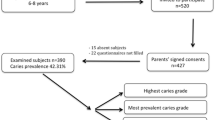Abstract
The aim of this three-phase prospective study was to determine the effects of a primary-primary prevention program on the oral health of children. Eighty-six pregnant women from various social backgrounds participated in the first phase of this study. In the second phase (at 3 years of age) 54 of the mother–child couples and in the third phase (at 4 years of age) 47 of the mother–child couples remained. Participants were recalled every 6 months and received individual prophylactic care. The following clinical parameters were assessed at each examination period for mother and child: DMF-S or dmf-s, proximal plaque index, and the salivary level of Streptococcus mutans (Dentocult SM). The control group consisted of 65 (at 3 years of age) and 45 (at 4 years of age) children from various kindergartens. All children in the second phase of the study group revealed a naturally healthy dentition with an API of 0–25% and a salivary S. mutans score of 0 (0–103 cfu/ml). In the third phase, only four of the 47 children of the study group showed caries, with a mean dmf-s of 1.5. No S. mutans could be detected in 20 (42.6%) children. Ten (21.3%) children of the study group showed a S. mutans score of ≥2 (>105 cfu/ml). In contrast, only 53 of the 65 children of the control group (second phase) and 26 of the 45 control children (third phase) revealed a naturally healthy dentition. The remaining 19 children of the control group revealed a mean dmf-s of 7.0 at 4 years of age. In the control group, no S. mutans could be detected in 25 (38.5%) children at 3 years of age whereas 21 (32.3%) children showed a S. mutans score of ≥2. In the third phase, a salivary S. mutans score of ≥2 was found in 27 (60%) children of the control group. The statistical comparison between the study and the control groups revealed significant differences for all results determined (P<0.001). Additionally, all mothers revealed a significant improvement in oral health and a reduction of salivary S. mutans colonization. From our data we conclude that a pre- and postnatal prevention program (primary-primary vs primary prevention) may significantly improve the oral health of mother and child.
Similar content being viewed by others
Author information
Authors and Affiliations
Additional information
Received: 12 June 1998 / Accepted: 7 July 1998
Rights and permissions
About this article
Cite this article
Günay, H., Dmoch-Bockhorn, K., Günay, Y. et al. Effect on caries experience of a long-term preventive program for mothers and children starting during pregnancy. Clinical Oral Investigations 2, 137–142 (1998). https://doi.org/10.1007/s007840050059
Issue Date:
DOI: https://doi.org/10.1007/s007840050059




